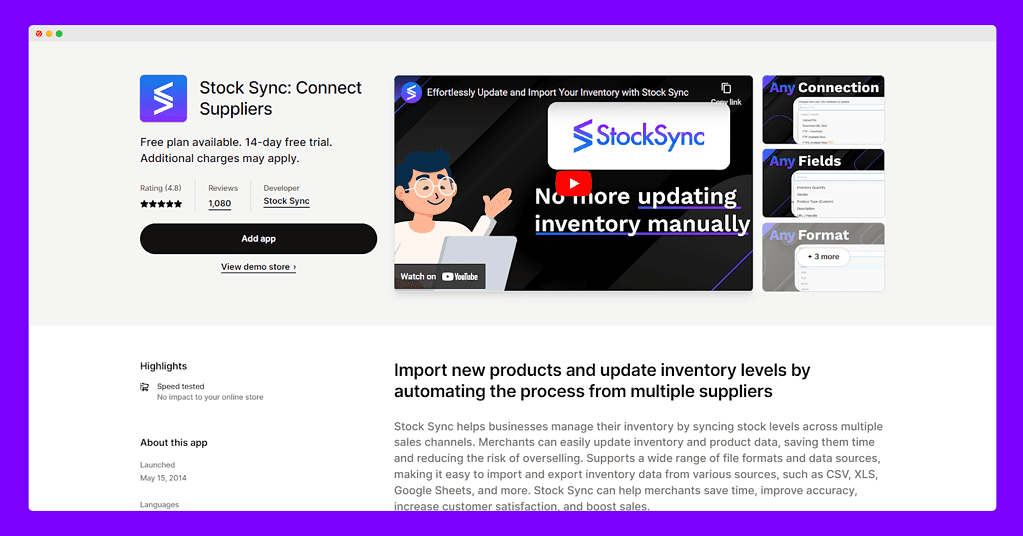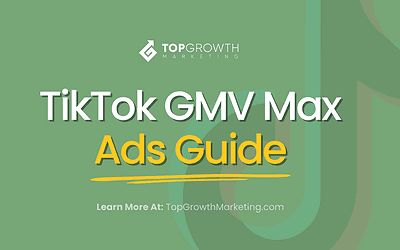Shopify has a vibrant and expansive ecosystem of users and developers that make store management easy and straightforward.
Unfortunately, sometimes that means getting paralyzed by too many choices. And that’s the case we see a lot when people are trying to find the best inventory management app for their store.
As a marketing agency deeply immersed in the Shopify ecosystem, we’ve seen firsthand the challenges faced by businesses and the impact the right tools can have on growth.
So, in this guide, we’ll make it easy for you. These are the best Shopify inventory management apps, so you can focus on the essentials — building relationships with customers, delivering value, and creating remarkable experiences.
Why Use Inventory Management Apps?
As you grow your Shopify store, the need for efficient inventory management becomes paramount. Inventory management apps equip us with the tools necessary to streamline this process. Here are some reasons why we should consider using inventory management apps:
- Efficiency: Inventory management apps empower us to track and fulfill orders with greater ease. You can quickly identify in-stock products and those requiring replenishment.
- Accuracy: With the right inventory management app, stockouts, and overselling will become a thing of the past. Maintaining accurate inventory levels helps you avoid losing sales due to stock shortages.
- Cost Savings: By reducing the risk of overstocking and understocking, you avoid wasting money on excess inventory or losing money due to lost sales.
- Time Savings: Inventory management apps automate many tasks associated with managing your inventory. Tasks that would otherwise take up a lot of time, which you probably don’t have a lot of as a store owner.
Overall, inventory management apps are a valuable tool for any Shopify business looking to scale and grow.
By using these apps, you can streamline the inventory management processes, reduce costs, and improve your overall efficiency.
Top Inventory Management Apps for Shopify
Stock Sync
Stock Sync is a versatile inventory management app designed for Shopify store owners who manage products from multiple suppliers. With its simple and powerful automation features, Stock Sync helps businesses keep their inventory up-to-date, prevent overselling, and save time by automating the importing and updating of product data.
Key Features:
- Seamless integration with Shopify and various file formats/data sources (CSV, XLS, Google Sheets, etc.).
- Automate the process of updating inventory levels, minimizing risk and time spent.
- Quantity rules allow users to adjust stock levels accordingly.
- Remove unwanted or discontinued products from the store.
Pros:
- Import new products and update inventory levels quickly and easily.
- Time-saving and efficient, reducing human error and overselling.
Cons:
- Limited customization options for advanced users.
- The interface has a bit of a learning curve, but not too bad
Pricing:
Stock Sync offers a 14-day free trial and has various pricing plans to cater to different needs. The Free Plan includes unlimited user trigger updates and a limit of 2,000 SKUs.
More advanced plans range from $5/month up to $49/month and include additional features, such as higher SKU limits, multiple update feeds, and scheduling options.
ShipBob
ShipBob is a reliable fulfillment solution that caters to both DTC and B2B brands, providing world-class logistics services to e-commerce businesses using more than 40 global locations
But, it also offers a lot of inventory management features that can make this a single-app solution for some stores.
By partnering with ShipBob, your brand can offer customers online orders picked, packed, and shipped on the same day, while also managing B2B/Wholesale orders, retailer compliance, and EDI documents.
It’s hard to overstate how big of a difference this can make for small-order retail purchases.
Key Features:
- Integration with various platforms, including Amazon, ShipStation, Walmart, and Facebook/Instagram.
- Customization suite for packaging, inserts, and brand experience.
- Same-day shipping, duties-paid shipping options, and warehouses in six countries.
- B2B/EDI compliance management.
- Free, easy-to-use Shopify integration, plus REST APIs for ERPs (e.g., Netsuite).
Pros:
- Seamless onboarding process thanks to a responsive implementation team.
- Accurate and timely order fulfillment is the norm, although we have seen some speed bumps in that regard.
- Active customer support that resolves any challenges promptly and professionally.
- Scalable to accompany business growth.
Cons:
- Occasional delays with deliveries and pickups — not a frequent problem but worth keeping in mind.
Pricing:
ShipBob’s app is free to install. However, additional charges apply depending on various factors, such as orders shipped, storage used in their warehouses, inventory received, and custom projects (like kitting and barcoding). All charges are billed in USD.
Extensiv Order Manager (Skubana)
Extensiv Order Manager, formerly known as Skubana, is a powerful order and inventory management software designed for e-commerce businesses.
It acts as a central hub providing complete visibility on orders, inventory, and fulfillment activities, simplifying order management and streamlining routine tasks.
The one big caveat is that it’s expensive.
If you’re already in a good position and profitable on several marketplaces, Skubana will take you to the next level. But be prepared to pay a hefty price to get there.
Key Features:
- Advanced routing and processing tools for automating order management.
- Control and replenish inventory with warehouses and 3PL partner integration.
- Integrate and track shipping with orderbots and order routing.
- Forecast future demand with integrated inventory automation tools.
Pros:
- Easy to set up and provides a comprehensive onboarding experience.
- Efficient order and inventory management across various sales channels.
- Continuous addition of new analytics tools and features.
- We can’t say enough good things about the customer support team for Skubana
Cons:
- Expensive for smaller businesses (to not say completely out of reach).
- Some purchasers have reported issues with the cancellation and refund process.
Pricing:
Extensiv Order Manager pricing starts at $1,000/month. This plan includes unlimited users, access to all features, and dedicated implementation specialists and account managers.
Visit Extensiv Order Manager on Shopify App Store
Sumtracker
Sumtracker is an inventory management app suitable for any e-commerce business, regardless of size.
It’s listed as Inventory Management & Bundles on the app store so don’t let that confuse you.
The app simplifies the inventory management process, offering multichannel synchronization, product bundles, and automated purchase orders.
With Sumtracker, you can easily manage inventory across multiple locations and platforms, including Shopify, Amazon, eBay, and Etsy.
Key Features:
- Inventory management for single and multi-store owners.
- Multichannel synchronization between Shopify, Amazon, eBay, and Etsy.
- Product bundles with auto-update on inventory.
- Purchase order management, including alert thresholds and lead times.
- Detailed inventory logs and easy bulk import/export options.
- Customizable workflow and low stock alerts.
Pros:
- Easy setup and integration with popular e-commerce platforms.
- Comprehensive inventory tracking and management features.
- Responsive and helpful customer support team.
Cons:
- Pricing if your order volumes are very high
Pricing:
Sumtracker offers a 30-day free trial and various pricing plans based on order volume, starting from $29/month for up to 100 orders and 2 store connections.
Additional pricing options include:
- $39/month (up to 250 orders and 5 store connections)
- $69/month (up to 500 orders and 5 store connections)
- $99/month (up to 1000 orders and 5 store connections).
All charges are billed in USD, with yearly discounts available.
Check Sumtracker on the app store
Trunk (Realtime Stock Sync & Bundling)
Trunk is a robust inventory synchronization and bundling app that helps e-commerce businesses keep their stock levels accurate across multiple sales channels.
The app integrates seamlessly with other platforms like Etsy, eBay, Amazon, and WooCommerce, ensuring real-time stock syncing and preventing overselling.
Key Features:
- Real-time stock level syncing for matching SKUs.
- Bundling and kitting to track components and materials.
- Low stock level alerts.
- Duplicate SKU syncing for businesses selling on multiple channels.
- Intuitive interface and easy setup, even for thousands of SKUs.
Pros:
- Lightning-fast synchronization across multiple sales channels.
- Prevents overselling and keeps track of bundles and duplicate SKUs.
- Quick and easy setup and excellent customer support.
Cons:
- Sometimes has syncing problems, causing incorrect inventory updates.
Pricing:
Trunk offers a 14-day free trial and several pricing plans. The Essential plan starts at $35/month. The Pro plan, which includes bundling and kitting, starts at $39 per month. More flexible pricing options are available based on the number of orders per month.
How to Choose the Best Inventory Management Apps for Shopify
When looking for the best inventory management app for your Shopify store, consider the following factors.
Multichannel support: the app should be able to collect data wherever you sell. That includes brick-and-mortar stores which means the app should be able to sync with your POS systems if needed.
Demand forecasting: the app should be able to analyze historical sales data and trends to help you predict future demand and manage your inventory accordingly.
Automation capabilities: the app should have tools to automatically update inventory levels, reorder products, and manage backorders. This will save you time and minimize human error.
Usability: When selecting an inventory management system, don’t be misled by flashy features that cloud the issue of usability.
Efficiency is key; if it takes too long for your staff to learn how to use the basic functions, invest your time and money elsewhere.
Opt for a system that is easy to use and intuitive, as it will better serve your goal of streamlining operations. You can always upgrade to a more feature-rich system down the line.
Customization: Your inventory management software must be customizable to support your retail business.
Research the system to verify if it meets your requirements and how you can customize it and take advantage of free trial periods if they’re available.
If you need added features, ensure the new system can easily integrate with your current system.
Conclusion — Measure Twice and Pick Your Inventory Management App Once
When it comes to choosing the right inventory management app for your Shopify store, it’s essential to carefully evaluate your business needs, objectives, and budget. Consider factors such as multichannel support, demand forecasting, automation capabilities, usability, and customization when making your decision.
Keep in mind that the ideal inventory management app should not only help you streamline your inventory management process, but also save you time, minimize human error, and ultimately, boost your bottom line.
Take full advantage of free trials and test different apps to determine which one best suits your business needs. Remember, you can always switch to a different app or upgrade to a more feature-rich system later on as your business grows and evolves.











0 Comments